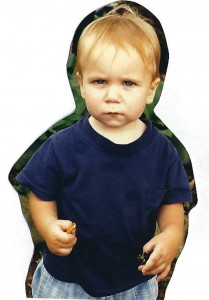“Hey, who’s the odd guy carrying that large net around along the edge of the woods over there?”
“I don’t know, but he sure looks silly doing whatever he’s doing!”
If you have ever seen someone with a net walking along the edge of the woods or along a roadside ditch, it might have been me in search of insects.

As a child, I picked up many insects. In my right hand I have a snack, but in my left hand, I have an insect.
Since I was a child, I have had an interest in finding insects. I can remember picking up cicadas at a family reunion when I was four or five years old, and since then, I was known as the bug boy in my family. Anytime a ‘strange’ looking insect appeared, I was immediately asked, “What is this?” or, “Is this going to sting me?” Once I was a bit older, I was asking the same people, “Can you catch it for me?”
As I grew older, I was introduced to the insect collecting project in 4-H, which is where I discovered my fascination of butterflies and moths. I would try and try to collect tiger swallowtails near my house, but they would fly up into the tree tops when I came running after them with my net. Not only were they difficult to collect, but once collected, they were difficult to properly prepare for my collection. I enjoyed learning to master the techniques with the butterflies so much, that I became attached to them and wanted to learn more and more about the life cycles, taxonomy, and anything else relating to them.
Towards the end of my senior year in high school, I decided to go to the Ohio State University to study entomology. While perusing the Entomology Department websites and other links associated with OSU, I came across the Triplehorn Insect Collection web page. As soon as I saw the web page and knew there was an insect collection, I wanted to be involved with it— especially if there was a chance that I would be working with butterflies and moths!
During my freshman year in college, I began working in the Triplehorn Insect Collection learning the basics while slowly being introduced to the butterflies and moths of the collection. During my sophomore year, I started working on the skipper butterflies. Not only do I work with skipper species from Ohio, but I work with the entire skipper collection. The broad goal of my project is to curate and database the entire skipper collection while focusing on a few Ohio species. During this project, I have gained experience with insect taxonomy, different computer software, and most of all, I felt a sense of accomplishment, knowing that I had been entrusted to work on an entire section of the collection.
This past summer, I was able to stay in Columbus, and I knew that I wanted to work in the insect collection. As a result, this was the perfect opportunity to meet the internship requirement for my entomology major and thus, I became an intern with the Triplehorn Insect Collection for the summer.
During my internship in the collection, I had three main areas of focus. The first focus was continuing the work with the skipper butterflies in the collection. My second focus was to learn the morphology of butterflies and moths with Dr. Steven Passoa, a National Lepidoptera Specialist with USDA/APHIS/PPQ. The third focus of my internship involved the databasing the darkling beetle collection, as part of a specimen data digitization project funded by the National Science Foundation.
Working with Dr. Passoa was one of the most enjoyable parts of my summer. He presented new techniques and ideas to me on a weekly basis that I could then apply to my work with the skipper butterflies and other areas of the butterfly and moth collection. His excitement for butterflies and moths fueled my own excitement for this group as I continued to work with him.
With the darkling beetle portion of my time this summer, I was able to apply many of the same techniques used with butterfly curation and databasing for the darkling beetles, but I also learned how to fix beetle specimens known as spinners – ones that swivel around their pin freely. I enjoyed being able to apply knowledge from other areas of the collection to the beetle collection this summer and learning new techniques with the beetles. Although I spent a large portion of my summer working closely with beetles, my heart did not sway away from butterflies and moths.

After the “spinner” specimen has been glued to the pin, the labels are placed back onto the specimen using forceps, a pinning block, and a steady hand.
It is safe to say after working with other groups of insects that my true interest is working with butterflies and moths. Whether carrying a net along the edge of a forest in search of new specimens, or sitting at a microscope identifying butterflies and moths, I am enjoying what I am involved with at the Triplehorn Insect Collection and I am learning a lot.
About the Author: Riley Gott is an Undergraduate Curatorial Assistant at the Triplehorn Insect Collection. He is majoring in Entomology (Class of 2017) and he loves butterflies.



